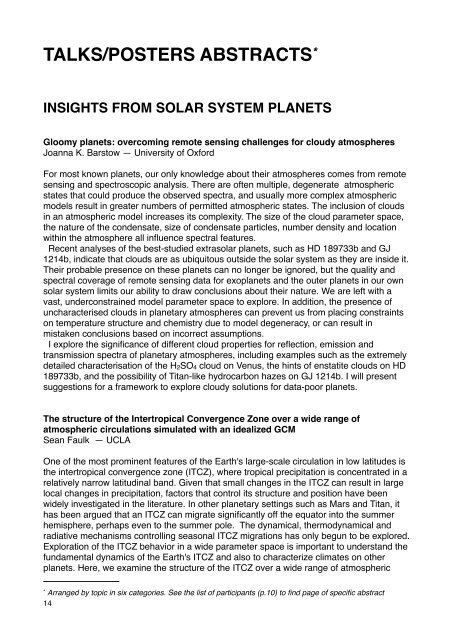Exoclimes_Conference_booklet1
Exoclimes_Conference_booklet1
Exoclimes_Conference_booklet1
You also want an ePaper? Increase the reach of your titles
YUMPU automatically turns print PDFs into web optimized ePapers that Google loves.
TALKS/POSTERS ABSTRACTS *<br />
INSIGHTS FROM SOLAR SYSTEM PLANETS<br />
Gloomy planets: overcoming remote sensing challenges for cloudy atmospheres<br />
Joanna K. Barstow — University of Oxford<br />
For most known planets, our only knowledge about their atmospheres comes from remote<br />
sensing and spectroscopic analysis. There are often multiple, degenerate atmospheric<br />
states that could produce the observed spectra, and usually more complex atmospheric<br />
models result in greater numbers of permitted atmospheric states. The inclusion of clouds<br />
in an atmospheric model increases its complexity. The size of the cloud parameter space,<br />
the nature of the condensate, size of condensate particles, number density and location<br />
within the atmosphere all influence spectral features.<br />
Recent analyses of the best-studied extrasolar planets, such as HD 189733b and GJ<br />
1214b, indicate that clouds are as ubiquitous outside the solar system as they are inside it.<br />
Their probable presence on these planets can no longer be ignored, but the quality and<br />
spectral coverage of remote sensing data for exoplanets and the outer planets in our own<br />
solar system limits our ability to draw conclusions about their nature. We are left with a<br />
vast, underconstrained model parameter space to explore. In addition, the presence of<br />
uncharacterised clouds in planetary atmospheres can prevent us from placing constraints<br />
on temperature structure and chemistry due to model degeneracy, or can result in<br />
mistaken conclusions based on incorrect assumptions.<br />
I explore the significance of different cloud properties for reflection, emission and<br />
transmission spectra of planetary atmospheres, including examples such as the extremely<br />
detailed characterisation of the H2SO4 cloud on Venus, the hints of enstatite clouds on HD<br />
189733b, and the possibility of Titan-like hydrocarbon hazes on GJ 1214b. I will present<br />
suggestions for a framework to explore cloudy solutions for data-poor planets.<br />
The structure of the Intertropical Convergence Zone over a wide range of<br />
atmospheric circulations simulated with an idealized GCM!<br />
Sean Faulk — UCLA!<br />
One of the most prominent features of the Earth's large-scale circulation in low latitudes is<br />
the intertropical convergence zone (ITCZ), where tropical precipitation is concentrated in a<br />
relatively narrow latitudinal band. Given that small changes in the ITCZ can result in large<br />
local changes in precipitation, factors that control its structure and position have been<br />
widely investigated in the literature. In other planetary settings such as Mars and Titan, it<br />
has been argued that an ITCZ can migrate significantly off the equator into the summer<br />
hemisphere, perhaps even to the summer pole. The dynamical, thermodynamical and<br />
radiative mechanisms controlling seasonal ITCZ migrations has only begun to be explored.<br />
Exploration of the ITCZ behavior in a wide parameter space is important to understand the<br />
fundamental dynamics of the Earth's ITCZ and also to characterize climates on other<br />
planets. Here, we examine the structure of the ITCZ over a wide range of atmospheric<br />
* Arranged by topic in six categories. See the list of participants (p.10) to find page of specific abstract<br />
14


